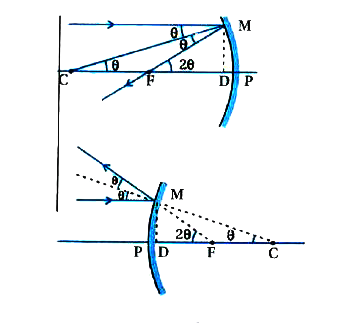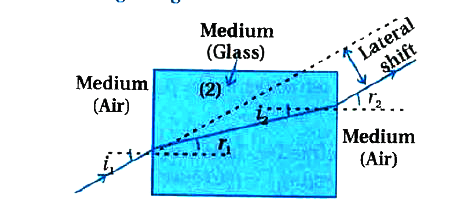Complete Solutions to SECTION - A (QUESTIONS - ANSWERS) of chapter RAY OPTICS AND OPTICAL INSTRUMENTS of Class 12 book with complete answers and questions
| Class 12 | PHYSICS |
| Chapter | RAY OPTICS AND OPTICAL INSTRUMENTS |
| KUMAR PRAKASHAN | SECTION - A (QUESTIONS - ANSWERS) |
| Number Of Questions | 68 |
| Academic Year | 2023-24 |
Write a short note on light.
View SolutionMention two main points about light.
View SolutionWhat is linear expansion of light ? Explain ray of light and beam of light.
View SolutionWhat is reflection of light ? Explain laws of reflection
View SolutionDiscuss sign convention of distances for reflection by spherical mirror and refraction by spherical lens.
View SolutionGive types of mirror.
View SolutionDefine following for curved mirrors (1) Radius of curvature (2) Centre of curvature (3) Pole (4) Principle axis (5) Aperture (6) Principle focus (7) Focal plane (8) Focal length (9) Paraxial Rays
View SolutionGive relation between focal length and radius of curvature for spherical mirror.

View SolutionWhat is image ? Explain its types.
View SolutionHow is it convenient to obtain image by reflection from spherical mirror ?
View SolutionExplain the ray diagram for image obtained for concave mirror by considering three rays.
View SolutionObtain mirror equation for the real image obtained by concave mirror.
View SolutionGive object and image distances, type, size and magnification for object placed in front of spherical mirror.
View SolutionWhat is linear magnification ? Obtain equation of linear magnification for concave mirror.
View SolutionWhat is refraction of light ? Explain laws of refraction.
View SolutionOnly draw a figure which explains the reflection and refraction of light.
View SolutionWhat is optically denser and optically rarer medium ?
View SolutionClear the meanings of optical density and mass density.
View SolutionWhat is absolute refractive index ? On what factor does it depend.
View SolutionWrite two definitions and equations of relative refractive index.
View SolutionExplain lateral shift for the refraction from rectangular glass slab.

View SolutionObtain the relation between the real depth and apparent depth of bottom of tank filled with water when observed from air.
View SolutionActually Sun is visible before Sunrise and after Sun set for some time. Explain this.
View SolutionExplain internal reflection and total internal reflection.
View SolutionExplain experiment which represents the total internal reflection.
View SolutionWhere the phenomena of total internal reflection can be observed ?
View SolutionWhy mirage formation is seen in deserts at the summer time?
View SolutionWhy the brilliance of diamond is observed ?
View SolutionExplain the phenomena of total internal reflection in right angle prism.
View SolutionExplain principle, construction and working of optical fibre.
View SolutionExplain the refraction by two transparent spherically curved surface.
View SolutionObtain the relative between object distance and image distance in terms of refractive index of medium and radius of curvature for spherically curved surface.
View SolutionExplain how the image is formed by thin convex lens and derive `-1/u+1/v=(n_(21)-1)[(1)/(R_1)+(1)/(R_2)]`
View SolutionObtain the equation of thin lens.
View SolutionFor more information about thin spherical lens, define :
(a) First principal focus `(F_1)`
(b) Second principal focus `(F_2)`
(c) Optical centre (C) (d) Focal length (f)

View SolutionGive object and image distances, type, size and magnification for object placed in front of thin lens.
View SolutionExplain first focal centre and second focal centre for lens.
View SolutionHow is it convenient to obtain image by lens practically?
View SolutionObtain the magnification by lens after giving its definition.
View SolutionDefine power of lens, obtain its equation and write its SI unit.
View SolutionObtain the equivalent focal length of combination of thin lenses placed in contact,
View SolutionObtain the equation of power for combination of lenses.
View SolutionObtain the equation of magnification of combination of lenses.
View SolutionObtain the relation between incidence angle, emergence angle, prism angle and deviation angle for refraction through prism
View SolutionDerive i+e=A+`delta` for a triangular glass prism.
View SolutionExplain the minimum deviation angle for prism by graph of deviation angle versus incidence angle.
View SolutionDerive `D_m = A(n_(21) - 1)` for thin prism.
View SolutionExplain dispersion of white light.
View SolutionExplain refractive index for light of different colours.
View SolutionExplain error of chromatic aberration.
View SolutionExplain dispersive and non-dispersive medium.
View SolutionDiscuss the natural phenomena occured due to Sunlight.
View SolutionWrite a note on rainbow.
View SolutionWhat is scattering of light ? And on which doe the scattering depend ?
View SolutionWhy the sky is blue when we see it?
View SolutionWhy does the Sun look reddish at the time of Sunrise and Sunset ?
View SolutionWhy the Moon is seen reddish at the time of its rise and set ?
View SolutionWhy clouds are seen to be of white colour ?
View SolutionWrite the name of instruments developed by the use of properties of reflection and refraction of mirror, lens and prism.
View SolutionWhat is simple microscope ? Obtain the equation of magnification for the image formed at normal vision distance.
View SolutionObtain the magnification for the image form at infinity for simple microscope.
View SolutionWhat is compound microscope ? Explain by figure of its construction.
View SolutionObtain the equation of magnification for compound microscope.
View SolutionWhat is telescope ? Discuss the types of telescopes that are used in general.
View SolutionExplain the construction of refracting telescope by figure and obtain the equation of its magnification.
View SolutionWhich are two main points important for astronomical telescope ?
View SolutionWhat are reflecting type of telescope ? Explain the advantages and disadvantages of reflecting telescopes as compared to refracting telescope and also give the solution.
View SolutionWrite a note on Cassegrain telescope.
View Solution
SECTION - A (QUESTIONS - ANSWERS) questions and complete solutions for chapter RAY OPTICS AND OPTICAL INSTRUMENTS of KUMAR PRAKASHAN KENDRA PHYSICS (GUJRATI ENGLISH) of Class 12
All Exercises from KUMAR PRAKASHAN Class 12 PHYSICS RAY OPTICS AND OPTICAL INSTRUMENTS
- SECTION - A (QUESTIONS - ANSWERS)
- SECTION - A (TRY YOURSELF)
- SECTION-B (NUMERICALS)(NUMERICAL FROM .DARPAN. BASED ON TEXTBOOK )
- SECTION-B (NUMERICALS)(NUMERICAL FROM TEXTUAL EXERCISE)
- SECTION-B (NUMERICALS)(NUMERICAL FROM TEXTUAL ILLUSTRATIONS)
- SECTION-C (NCERT EXEMPLAR SOLUTION) (LONG ANSWER TYPE QUESITONS)
- SECTION-C (NCERT EXEMPLAR SOLUTION) (MULTIPLE CHOICE QUESTIONS (MCQs))
- SECTION-C (NCERT EXEMPLAR SOLUTION) (SHORT ANSWER TYPE QUESITONS)
- SECTION-C (NCERT EXEMPLAR SOLUTION) (VERY SHORT ANSWER TYPE QUESITONS)
- SECTION-D (MULTIPLE CHOICE QUESTIONS (MCQs))(MCQs ASKED IN COMPETITIVE EXAMS)
- SECTION-D (MULTIPLE CHOICE QUESTIONS (MCQs))(MCQs FROM .DARPAN. BASED ON TEXTBOOK)
- SECTION-D (MULTIPLE CHOICE QUESTIONS (MCQs))(MCQs FROM .DARPAN. BASED ON TEXTBOOK)(MCQs BASED ON TEXTUAL ILLUSTRATION AND EXERCISE)
- SECTION-D (MULTIPLE CHOICE QUESTIONS (MCQs))(MCQs FROM .DARPAN. BASED ON TEXTBOOK)(NATURAL PHENOMENA DUE TO SUN LIGHT )
- SECTION-D (MULTIPLE CHOICE QUESTIONS (MCQs))(MCQs FROM .DARPAN. BASED ON TEXTBOOK)(OPTICAL INSTRUMENTS)
- SECTION-D (MULTIPLE CHOICE QUESTIONS (MCQs))(MCQs FROM .DARPAN. BASED ON TEXTBOOK)(REFRACTION AND DISPOSION BY PRISM)
- SECTION-D (MULTIPLE CHOICE QUESTIONS (MCQs))(MCQs FROM .DARPAN. BASED ON TEXTBOOK)(REFRACTION)
- SECTION-D (MULTIPLE CHOICE QUESTIONS (MCQs))(MCQs FROM .DARPAN. BASED ON TEXTBOOK)(REFRACTION, MAGNIFICATION, POWER AND COMBINATION OF LENS)
- SECTION-D (MULTIPLE CHOICE QUESTIONS (MCQs))(MCQs FROM .DARPAN. BASED ON TEXTBOOK)(TOTAL INTERNAL REFLECTION)